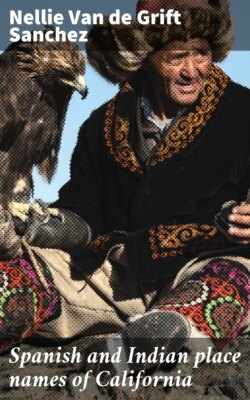Читать книгу Spanish and Indian place names of California - Nellie van de Grift Sanchez - Страница 13
На сайте Литреса книга снята с продажи.
EL RANCHO LA BREA
ОглавлениеTable of Contents
La Brea (the asphalt), has been retained as the appropriate designation of the ranch containing the famous asphaltum beds near Los Ángeles. Ever since the days of the Tertiary Age, the quaking, sticky surface of these beds has acted as a “death trap” for unwary animals, and the remains of the unfortunate creatures have been securely preserved down to our times, furnishing indisputable evidence of the strange life that once existed on our shores. Fossils of a large number of pre-historic and later animals have been taken out, aggregating nearly a million specimens of bird and animal life, many of them hitherto unknown to science. Among them are the saber-tooth tiger, gigantic wolves, bears, horses, bison, deer, an extinct species of coyote, camels, elephants, and giant sloths. Remains are also found of mice, rabbits, squirrels, several species of insects, and a large number of birds, such as ducks, geese, pelicans, eagles and condors.
Among the most remarkable of these fossils are the saber-tooth tiger and the great wolf. Specimens of the wolf have been found which are among the largest known in either living or extinct species. This wolf differs from existing species in having a larger and heavier skull and jaws, and in its massive teeth, a conformation that must have given it great crushing power. The structure of the skeleton shows it to have been probably less swift, but more powerful than the modern wolf, and the great number of bones found indicate that it was exceedingly common in that age. One bed of bones was uncovered in which the number of saber-tooth and wolf skulls together averaged twenty per cubic yard. Altogether, the disappearance of these great, ferocious beasts from the California forests need cause no keen regret.
Next to the large wolf the most common is the saber-tooth tiger, of which one complete skeleton and a large number of bones have been found. The skeleton shows the animal to have been of about the size of a large African lion, and its most remarkable characteristic was the extraordinary length of the upper canine teeth, which were like long, thin sabers, with finely serrated edges. These teeth were awkwardly placed for ordinary use, and it is thought by scientists that they were used for a downward stab through the thick necks of bulky creatures, such as the giant sloth. There is also an unusual development of the claws, possibly to make up for the loss of grasping power in the jaws, resulting from the interference of the long saber teeth. It appears from the state of many of the fossils that these teeth were peculiarly liable to fracture, and accidents of this sort may have led to the extinction of the species, the animal thus perishing through the over-development of one of its characteristics.
Fossils of the extinct horse and bison are common, and a smaller number are found of camels, deer, goats, and the mammoth. The bison were heavy-horned and somewhat larger than the existing species of buffalo. The camel, of which an almost complete specimen has very recently been taken out by Professor R. C. Stoner, of the University of California, was much larger than the present day species. Since the above was put in type, a human skeleton has been taken from the vicinity of the La Brea bed. Whether this skeleton belongs with the La Brea deposits, and what its comparative age in relation to other human remains may be, are matters now being investigated by scientists.
The preponderance of meat-eating animals in the La Brea beds has attracted the attention of scientists, who believe that these creatures were lured to the spot in large numbers by the struggles and cries of their unfortunate prey caught in the sticky mass of the tar. In this way, a single sloth, or other creature, may have been the means of bringing retribution upon a whole pack of wolves.—(Notes taken from an article in the Sunset Magazine of October, 1908, entitled The Death Trap of the Ages, by John C. Merriam, Professor of Paleontology in the University of California.)
The manner in which this great aggregation of animals came to a tragic end in that long-past age is exemplified in the way that birds and other small animals are still occasionally caught in the treacherous asphalt and there perish miserably, adding their bones to those of their unhappy predecessors.
The La Brea beds furnish one of the richest fields for paleontological research to be found anywhere in the world; and it may be said, that with her great Sequoias in the north, and her reservoir of pre-historic remains in the south, California stands as a link between a past age and the present.
The tarry deposit itself has its own place in history, for it appears that the first settlers of Los Ángeles were alive to the practical value of this supply of asphaltum lying ready to their hands, and used it in roofing their houses. Even the Indians, little as is the credit usually given them for skill in the arts and crafts, recognized the possibilities of this peculiar substance, and used it in calking their canoes.
